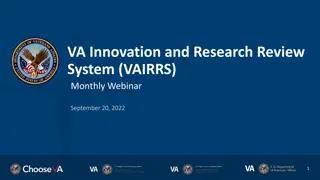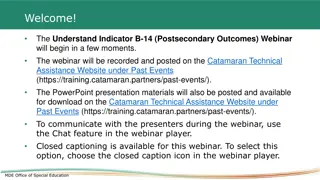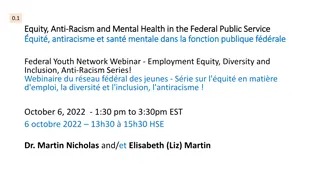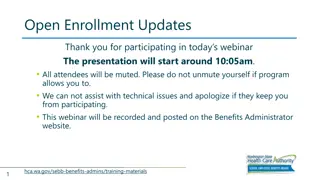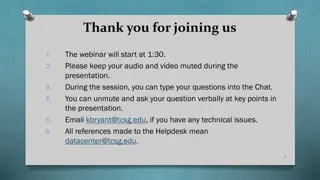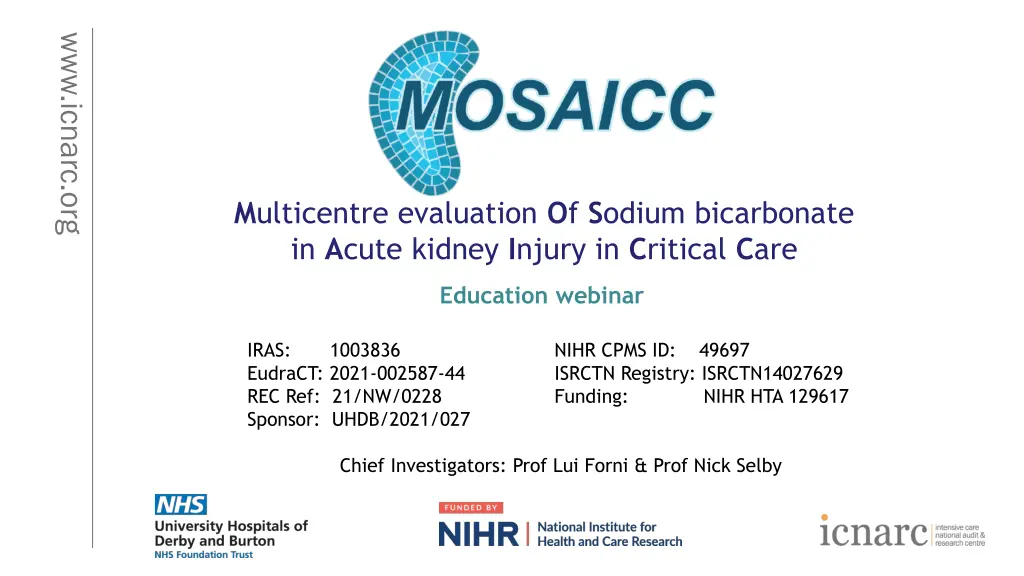
Multicentre Evaluation of Sodium Bicarbonate in Acute Kidney Injury - Trial Update
Explore the latest trial update from www.icnarc.org on the multicentre evaluation of sodium bicarbonate in acute kidney injury in critical care. Get insights on exclusion criteria, recruitment progress, top recruiters, and clinical scenarios discussed. Stay informed on the ongoing research efforts in this critical area of study.
Uploaded on | 2 Views
Download Presentation

Please find below an Image/Link to download the presentation.
The content on the website is provided AS IS for your information and personal use only. It may not be sold, licensed, or shared on other websites without obtaining consent from the author. If you encounter any issues during the download, it is possible that the publisher has removed the file from their server.
You are allowed to download the files provided on this website for personal or commercial use, subject to the condition that they are used lawfully. All files are the property of their respective owners.
The content on the website is provided AS IS for your information and personal use only. It may not be sold, licensed, or shared on other websites without obtaining consent from the author.
E N D
Presentation Transcript
www.icnarc.org Multicentre evaluation Of Sodium bicarbonate in Acute kidney Injury in Critical Care Education webinar IRAS: EudraCT: 2021-002587-44 REC Ref: 21/NW/0228 Sponsor: UHDB/2021/027 1003836 NIHR CPMS ID: 49697 ISRCTN Registry: ISRCTN14027629 Funding: NIHR HTA 129617 Chief Investigators: Prof Lui Forni & Prof Nick Selby
Agenda Trial Update A closer look at the Exclusion criteria Clinical scenarios / FAQs Discussion and questions www.icnarc.org 2
Trial Update www.icnarc.org Aim: 70 participating hospitals Current: 70 Welcome to Aintree Hospital Glasgow Royal Infirmary George Eliot Hospital 3
Trial Update Recruitment www.icnarc.org As of the 31st May, 549 patients randomised A total of 22 in April and 31 in May Monthly recruitment vs. Sites open 80 70 60 50 40 30 20 10 0 Actual monthly recruitment Actual sites open cumulative 4
www.icnarc.org Top recruiters Top recruiter in April: St Georges Hospital and Lincoln County Hospital (3 each) Top recruiter in May: Royal Derby Hospital and Broomfield Hospital (3 each) Recruited their first patient: o Leeds General Infirmary o Glasgow Royal Infirmary 5
Agenda Trial Update A closer look at the Exclusion criteria Clinical scenarios / FAQs Discussion and questions www.icnarc.org 6
A closer look at the Exclusion criteria www.icnarc.org If corrected, patient may be reconsidered for trial 1. Respiratory acidosis (acute or chronic) 2. KRT immediately indicated and treating clinician(s) unwilling to defer if randomised to sodium bicarbonate 3. Deemed unsuitable for KRT 4. High output stoma/ileostomy 5. Percutaneous biliary drainage 6. End stage kidney failure defined as documented eGFR<15 ml/min/1.73m2 prior to onset of this acute illness or end stage kidney disease (ESKD) on dialysis 7. Known renal tubular acidosis 8. Diabetic ketoacidosis 9. High anion gap acid poisoning (e.g. PEG, aspirin, methanol) 10. Symptomatic hypocalcaemia (Ionised calcium <1.05 mmol/L)* 11. Hypernatraemia (Plasma sodium >150 mmol/L)* 12. Severe hypokalaemia (Potassium <3.0 mmol/L)* 13. Death perceived as imminent 14. Known hypersensitivity to IMP or excipients 15. Previously randomised into MOSAICC Intended to exclude those with pre-existing kidney failure or on long-term chronic dialysis 7
Agenda Trial Update A closer look at the Exclusion criteria Clinical scenarios / FAQs Discussion and questions www.icnarc.org 8
www.icnarc.org Scenario 1 You are screening a patient and note the following: Patient has a metabolic acidosis. Creatinine is not double the baseline. U/O is very borderline but if you take the past 12 hours, they are just passing more than 0.5ml/kg/hr. Looking back today though there have been 12-hour periods where the urine output has been <0.5ml/kg/hr. Is this patient eligible or not eligible for MOSAICC? 9
www.icnarc.org Scenario 1 - Answer Very borderline Given the information, currently not eligible However, with the low urine output then the creatinine should be rising. So, the patient would become eligible if the UO drops to <0.5, or if they repeat the creatinine and it s gone up. One to keep watching! 10
www.icnarc.org Scenario 2 The patient has chronic kidney disease stage 4, over the past year creatinine has been very variable (some <354, some >354). eGFR prior to current admission variable but around 23 (no values <15) Acidotic and meets urine output criteria patient is already receiving Bicarb 1.4% IV (still acidotic). Is this patient eligible or not eligible for MOSAICC? 11
www.icnarc.org Scenario 2 Answer The patient is eligible. They do not meet the end stage kidney failure exclusion criteria as the eGFR is > 15. Therefore, if the patient meets all the inclusion criteria, with the metabolic acidosis (defined by arterial blood gas values of pH <7.30 and PaCO2 <6.5 kPa) being met at the time of randomisation (i.e. values are from the most recent ABG) and has AKI based on UO, then this patient would be eligible. The patient should be a candidate for KRT. 12
www.icnarc.org Scenario 3 You are screening a patient in the ITU and discover that they had a previous renal transplant. They meet all of the inclusion and none of the exclusion criteria. Is this patient eligible or not eligible for MOSAICC? 13
www.icnarc.org Scenario 3 - Answer Transplant is not an exclusion criteria, so this patient is eligible for MOSAICC. PPI input during the design of the trial, was that renal transplant patients should be involved! 14
www.icnarc.org Scenario 4 A patient is commenced on KRT and the filter clots off and the patient re-develops a metabolic acidosis and meets all the inclusion criteria. Is this patient eligible or not eligible for MOSAICC? 15
Scenario 4 - Answer www.icnarc.org No, if the clinical plan is to continue with KRT 16
Scenario 5 Patient has been in ICU for several weeks, and previously received KRT. AKI had recovered with good urine output and vascath has been removed. One week later, situation deteriorates, there is a further episode of AKI with acidosis and the inclusion criteria for MOSAICC are now met. Is this patient eligible? www.icnarc.org 17
Scenario 5 In this situation, we are advising that these patients are eligible www.icnarc.org The logic is that in this scenario, the research question as to whether bicarbonate is effective or not still applies 18
Scenario 6 Patient was originally admitted for DKA and was treated for this. Patient still on variable rate insulin because she isn't feeding yet. They now meet AKI and acidosis inclusion criteria. Does this class as an exclusion? www.icnarc.org 19
Scenario 6 - Answer DKA is an exclusion if the patient is currently being treated for it, and sodium bicarbonate would not be appropriate to be administer. As in this case, once the DKA has resolved and if the participant meets all eligibility criteria, then they can be randomised. www.icnarc.org 20
www.icnarc.org Scenario 7 The patient we randomised to the intervention arm yesterday currently has a mixed respiratory and metabolic acidosis, i.e. the base excess is low (<2.0), and the PaCO2 is elevated (>6kPa). Prior to randomisation, the PaCO2 was normal or low. The clinical care team are concerned that the IV sodium bicarbonate is driving the hypercarbia. Further, should the PaCO2 continue to increase, the consultants may decide to stop the intervention. What do you advise? 21
www.icnarc.org Scenario 7 - Answer If the respiratory acidosis is causing the low pH then yes, this would be an acceptable reason for not giving sodium bicarbonate to a participant in the intervention group This applies for a mixed acidosis and at any point post randomisation The deviation should be recorded on the Sodium bicarbonate administration deviation form on MACRO. 22
Scenario 8 Patient meets all the criteria s for MOSAICC Trial. Suspected brain injury with possibility for withdrawal of treatment in 48 hours due to patient deterioration Focus of care currently is determining the level of brain injury and not AKI www.icnarc.org Do you randomise the patient? 23
Scenario 8 - Answer A familiar but none the less depressing scenario. I would suggest that the consultants probably do not think that the patient is a candidate for RRT. If they are not, then they cannot be randomised. Also, it sounds like the prognosis is guarded so again this would support a decision not to randomise. www.icnarc.org 24
www.icnarc.org FAQ Qu. If a patient has received sodium bicarbonate prior to randomisation (either on the ward or in ITU) would they be excluded from entry into the study? Ans: No. Receiving any concentration of sodium bicarb prior to randomisation is not an exclusion. They can still be randomised into MOSAICC. However, the clinical team must agree to stop administering sodium bicarbonate if the patient is randomised to the No Sodium Bicarbonate Arm. 25
www.icnarc.org FAQ Qu. Can we use up to 12 hours of pre-Critical Care urine output data for determining whether patients meet the AKI criteria at the point of Critical Care admission Ans: Yes
www.icnarc.org Any Questions? 27
www.icnarc.org Coming up Next drop-in session: o 26th June 2024 13:00-14:00 o Reminder, this session is for: Staff who require training to perform eligibility/randomisation tasks Staff who would like a refresher/recap/chance to ask questions MOSAICC Investigator Meeting o 13th September 2024, Ect Venues Chancery Lane (London) o Email with registration details have been sent out 28
Thank you! www.icnarc.org MOSAICC@icnarc.org 020 7269 9284 https://www.icnarc.org/research- studies/mosaicc/for-sites/ 29












